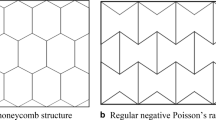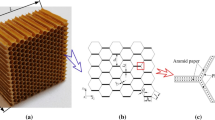Abstract
This paper investigated the compressive mechanical properties of antitetrachiral honeycombs with different thickness ratios of ligament to cylinder. The deformation and energy absorption performance of the structures were characterized by the cooperation of experimental and numerical methods. First, two types (small and large thickness ratios) of antitetrachiral honeycombs were manufactured by 3D printing. Then, the deformation mode, negative Poisson’s ratio (NPR) and crushing stress of the honeycombs were obtained experimentally. After that, a finite element (FE) model was established by using ABAQUS/Explicit, and the numerical model and method were validated. Based on experimental and numerical results, the X mode, double-parallel line mode and cylinder mode were obtained in the compressive deformation of the honeycomb with a small thickness ratio. The Bi-V mode, “\(\equiv \)” mode and Z mode were obtained in the compressive deformation of the honeycomb with a large thickness ratio. The influence of the thickness ratio of ligament to cylinder was studied, and a thickness ratio of 1.625 was the critical value for the transformation of the antitetrachiral honeycomb deformation modes.






Similar content being viewed by others
References
Barnes AT, Ravi-Chandar K, Kyriakides S, et al. Dynamic crushing of aluminum foams: part I - experiments. Int J Solids Struct. 2014;51(3):1631–45.
Mousanezhad D, Haghpanah B, Ghosh R, et al. Elastic properties of chiral, anti-chiral, and hierarchical honeycombs: A simple energy-based approach. Theor App Mech Lett. 2016;6(2):81–96.
Qiao JX, Chen CQ. Impact resistance of uniform and functionally graded auxetic double arrowhead honeycombs. Int J Impact Eng. 2015;83:47–58.
Novak N, Hokamoto K, Vesenjak M, et al. Mechanical behaviour of auxetic cellular structures built from inverted tetrapods at high strain rates. Int J Impact Eng. 2018;122:83–90.
Allen T, Hewage T, Newton-Mann C, et al. Fabrication of auxetic foam sheets for sports applications. Phys Status Solidi B Basic Res, 2017, 254(12).
Miller W, Smith CW, Evans KE. Honeycomb cores with enhanced buckling strength. Compos Struct. 2011;93(3):1072–7.
Levy O, Krylov S, Goldfarb I. Design considerations for negative Poisson ratio structures under large deflection for MEMS applications. Smart Mater Struct. 2006;15(5):1459–66.
Spadoni A, Ruzzene M. Static Aeroelastic Response of Chiral-core Airfoils. J Intell Mater Syst Struct. 2016;18(4):1067–75.
Ali MN, Rehman IU. An Auxetic structure configured as oesophageal stent with potential to be used for palliative treatment of oesophageal cancer; development and in vitro mechanical analysis. J Mater Sci Mater Med. 2011;22(11):2573–81.
Hu LL, Wu ZJ, Fu MH. Mechanical behavior of anti-trichiral honeycombs under lateral crushing. Int J Mech Sci. 2018;140:537–46.
Wu W, Geng L, Niu Y, et al. Compression twist deformation of novel tetrachiral architected cylindrical tube inspired by towel gourd tendrils. Extreme Mech Lett. 2018;20:104–11.
Qi D, Yu H, Hu W, et al. Bandgap and wave attenuation mechanisms of innovative reentrant and anti-chiral hybrid auxetic metastructure. Extreme Mech Lett. 2019;28:58–68.
Mohanraj H, Filho Ribeiro SLM, Panzera TH, et al. Hybrid auxetic foam and perforated plate composites for human body support. Phys Status Solidi B Basic Res. 2016;253(1):1378–86.
Slann A, White W, Scarpa F, et al. Cellular plates with auxetic rectangular perforations. Phys Status Solidi B Basic Res. 2015;252(1):1533–9.
Logakannan KP, Ramachandran V, Rengaswamy J, et al. Quasi-static and dynamic compression behaviors of a novel auxetic structure. Compos Struct, 2020, 254.
Lu H, Wang X, Chen T. In-plane dynamics crushing of a combined auxetic honeycomb with negative Poisson’s ratio and enhanced energy absorption. Thin Wall Struct, 2021, 160.
Li T, Chen Y, Hu X, et al. Exploiting negative Poisson’s ratio to design 3D-printed composites with enhanced mechanical properties. Mater Des. 2018;142:247–58.
Chen YJ, Scarpa F, Liu YJ, et al. Elasticity of anti-tetrachiral anisotropic lattices. Int J Solids Struct. 2013;50(6):996–1004.
Wu W, Song X, Liang J, et al. Mechanical properties of anti-tetrachiral auxetic stents. Compos Struct. 2018;185:381–92.
Miller W, Smith CW, Scarpa F, et al. Flatwise buckling optimization of hexachiral and tetrachiral honeycombs. Compos Sci Technol. 2010;70(1):1049–56.
Farrugia PS, Gatt R, Grima JN. A novel three-dimensional anti-tetrachiral honeycomb. Phys Status Solidi B Basic Res, 2018.
Farrugia P-S, Gatt R, Zammit Lonardelli E, et al. different deformation mechanisms leading to auxetic behavior exhibited by missing rib square grid structures. Phys Status Solidi B Basic Res, 2019, 256(1).
Dong Z, Li Y, Zhao T, et al. Experimental and numerical studies on the compressive mechanical properties of the metallic auxetic reentrant honeycomb. Mater Des, 2019, 182.
Li QM, Magkiriadis I, Harrigan JJ. Compressive Strain at the Onset of Densification of Cellular Solids. J Cell Plast. 2016;42(5):371–92.
Author information
Authors and Affiliations
Corresponding author
Rights and permissions
About this article
Cite this article
Hu, J., Lin, Y. & Chen, W. Studies on the Compressive Mechanical Properties of Antitetrachiral Honeycombs with Different Thickness Ratios of Ligament to Cylinder. Acta Mech. Solida Sin. 35, 470–480 (2022). https://doi.org/10.1007/s10338-021-00300-5
Received:
Revised:
Accepted:
Published:
Issue Date:
DOI: https://doi.org/10.1007/s10338-021-00300-5




